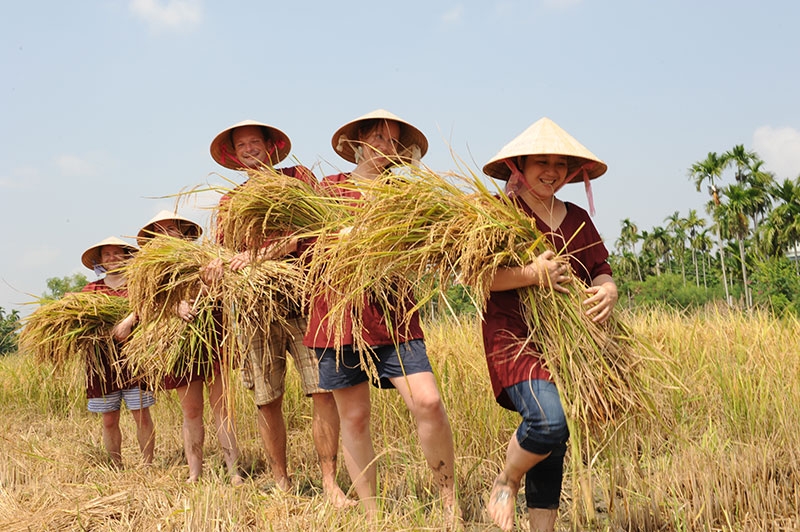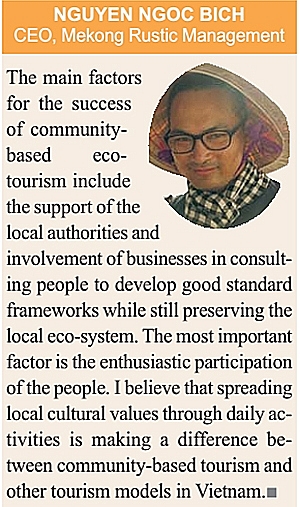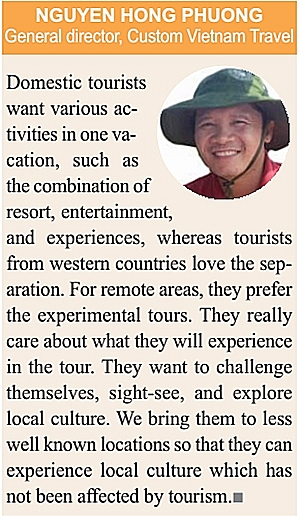Community-based ecotourism thrives
 |
| Community-based ecotourism thrives |
New direction
A part of responsible tourism, community-based ecotourism is a model based on the ability to balance the reasonable exploitation of resources with the local community’s responsibility to protect and preserve the natural environment. In particular, the local community is the key factor in making this tourism model attractive and successful. They will directly participate in the process of introducing the area, supplying products, and guiding visitors towards enjoyable experiences.
Travel companies now only act as consultants, connecting visitors with local tourism products and ensuring that visitors have the best experience.
The AC Nielsen’s survey of travel trends shows that 65 per cent of travellers want to experience local cultural heritage, 54 per cent of visitors wish to experience nature tourism, and 97 per cent of travellers are willing to pay more for an environmentally friendly holiday.
In recent years, Vietnam’s tourism industry has been promoting community-based tourism in general and community-based ecotourism in particular as a unique product to attract international visitors. With the increasing number of international visitors, the diversified natural potential, and the uniqueness of the culture, ecotourism has a lot of opportunities to develop in Vietnam.
“Community-based ecotourism is a trend for sustainable development in the future. If it succeeds, it will make a difference in Vietnam’s tourism compared to the tourism products of other countries, and then the competition will be greatly reduced,” said Nguyen Ngoc Bich, general director of Mekong Rustic Management.
|
|
|
Each household is a travel agency
Some localities have already applied this model and initially achieved great success. In the mountainous areas where many ethnic minorities live, such as Lao Cai, Ha Giang, and Hoa Binh, this model has brought about practical effects and contributed to improving the lives of many people.
Coming to Mai Chau, tourists have the chance to live in the unique stilt-houses of the Thai tribe, and participate in daily local activities such as weaving, bamboo dancing, and enjoying traditional cuisine. In Sapa, H’Mong villages such as Ta Van, Ta Phin, Cat Cat, and Lao Chai have become attractive destinations for foreign tourists.
Despite appearing later, this model also brought many successes in the northern province of Quang Ninh, especially in some of the unspoilt islands such as Quan Lan, Minh Chau and Co To.
In the central region, Hoi An (in the central province of Quang Nam) is cited as having opportunities for developing community-based tourism, with such familiar destinations as Tra Que Herbal Village, Cu Lao Cham Island, as well as ecotourism sites associated with the nipa palm forests and canals along the Thu Bon River, and fishing villages along An Bang and Cua Dai beaches.
In the Mekong Delta, an area well known for its ecotourism tours, visitors can immerse themselves in the local living space and experience the activities of the water region such as fishing, harvesting fruits, enjoying floating markets, and listening to traditional music with local amateur artists. Many travel companies also co-operate with homestays to organise tours which appeal to foreigners, such as “Be a farmer for a day” in Cai Be (Tien Giang province), and “A foreigner in my house” (Vinh Long province).
Simone Kapitza, a German tourist visiting An Giang province, said, “Only community-based ecotourism helps me to experience nature and understand the aspirations of this land.”
What the stars mean:
★ Poor ★ ★ Promising ★★★ Good ★★★★ Very good ★★★★★ Exceptional
Related Contents
Latest News
More News
- The destinations powering Vietnam’s festive season travel demand (December 04, 2025 | 18:33)
- Vietnam named among the world’s most exciting winter destinations (December 04, 2025 | 15:10)
- Phu Tho emerges as northern Vietnam’s new tourism hub (December 01, 2025 | 17:00)
- Vietjet completes Airbus A320/A321 updates ahead of deadline (December 01, 2025 | 09:49)
- Vietjet resumes Con Dao flights from early December (November 28, 2025 | 15:24)
- Free tickets, Lunar New Year promotions on offer at Vietjet Mega Livestream (November 26, 2025 | 15:32)
- Scandinavian Airlines and Vietnam Airlines broaden agreement with new routes (November 25, 2025 | 17:04)
- Halong Cruise Port welcomes over 3,100 international visitors (November 12, 2025 | 18:06)
- Vietnam.travel climbs to second place in Southeast Asia website rankings (November 12, 2025 | 18:01)
- Cat Ba named among Southeast Asia’s top island adventures (November 11, 2025 | 18:09)




 Tag:
Tag:


















 Mobile Version
Mobile Version